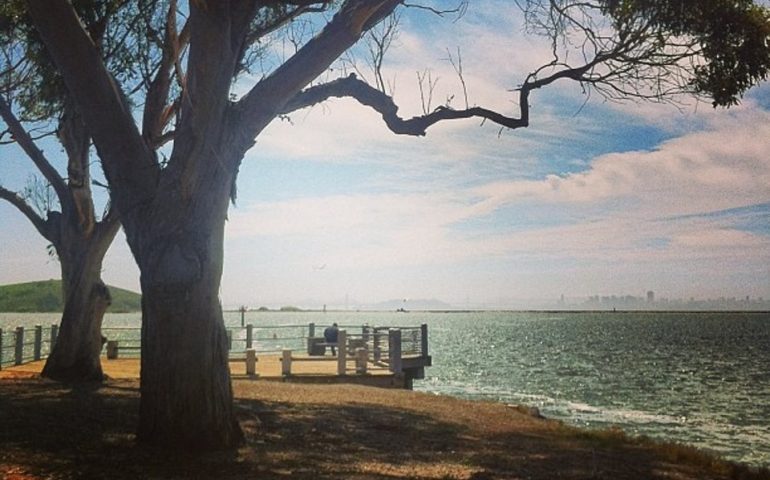Public Pier — No Fishing License Required
Early in the 21st Century I began to get reports on the “dayglo pier” in Richmond, which, as I understood it, was not a public pier. In response, I did not include it in Pier Fishing In California, 2nd Edition. Later, I found out that it was indeed a public pier.
Location of the pier is in the John J. Sheridan Observation Point Park, a small park that has few amenities to attract people with one large exception — the small pier.
As is usual, anglers aren’t too concerned with the amenities, they mainly care about one thing—will the pier’s waters yield up some fish? The answer seems to be yes and that’s why a steady group of local anglers used the pier.
However, there is somewhat of an elephant in the room, a problem that does not appear to be going away anytime soon. It’s the fact that the water around the pier is some of the most polluted water in San Francisco Bay and the fish that are caught should probably not be eaten That toxic pollution explains the nickname that was given to the pier — the dayglo pier.
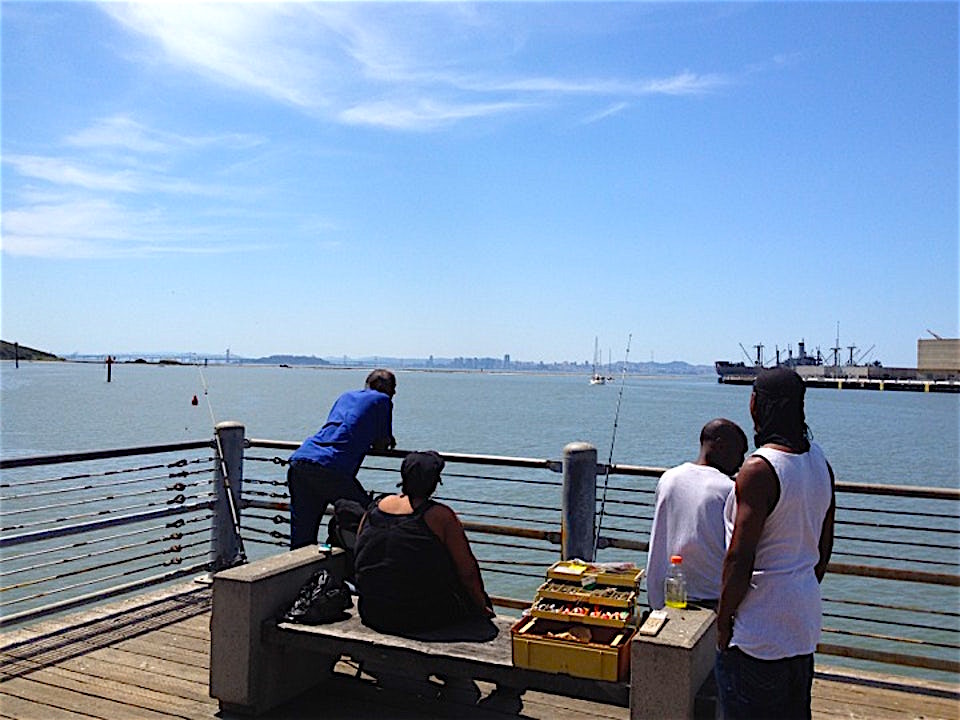
Environment: The short pier reaches out into the water from Sheridan Point (aka Ford Point), a point that fronts on the waters of the Richmond Inner Harbor.
To the right (west) of the pier is the Harbor Channel used by ships to get to Port Terminals No. 2 and 3 as well as other wharves. Toward the end of the channel is a wastewater plant.
Water moving past the pier to the left (east) flows along Ford Channel before entering into the Inner Harbor Basin and Marina Bay.
Although the pier extends only a short distance over the water, a fairly good water depth can be achieved with a decent cast and that’s where the bigger fish, sharks and rays, normally call their home. Currents although usually mild can be strong dependent upon the tides.
The pier has nice railings (that are safe for children), while the surface is wooden. Amenities are limited to a few benches.
Adjacent to the pier, on the left, is a small dock that can, at times, see a few perch hanging under it for protection; its waters are reachable with a short cast. The shoreline on the right is mostly riprap rock intended to armorize and protect the shoreline from erosion.
The area has been known for a long times as Richmond’s Industrial Village, an area characterized by heavy industry that at one time included the huge Ford Assembly Plant and Kaiser Shipyard. That early industry is at least in part responsible for the pollution that remains in the benthic muds and water of the area.
The worms and the other organisms that live in the toxic mud are eaten by bottom feeding fish. Those fish ingest the toxins and they in turn have toxins in the fatty parts of their flesh. People who eat that flesh in turn ingest toxins which lodge, I assume, in the fatty parts of their flesh. Not a good mix.
As a consequence, these fish should not be eaten. But some people refuse to heed the advice. Hopefully, they at least do the following: (a) Clean the fish well removing all guts and innards that contain toxins; (b) Cook the fish by broiling or bbq’ing the fish. That will melt some of the fat in the tissue and it will fall away with the cooking. Don’t coat and fry the fish, a method that simply keeps the toxins in the flesh; (c) Eat the fish in moderation since it’s impossible to remove all toxins from the flesh. But, as said, the best approach is simply not to eat fish caught in the area. Catch and release is a good slogan for the pier.
A definite plus at the pier are some great views of San Francisco and Oakland.
Fishing Tips. Although I would rate the action at the pier as only fair, it does see good fishing at times. Fish counts done by the Department of Fish and Wildlife at the pier showed the number one fish to be kingfish (white croaker) followed by jacksmelt and perch. Reports to Pier Fishing In California website mostly have highlighted a different story, the fishing for sharks and rays, which can be excellent at times.
If seeking out the white croaker, a simple high/low rig with size 4 hooks is used. Pieces of anchovy or sardine (any oily fish) for bait usually produce the best results. Casting out from the pier, letting the rig sink to the bottom, and being prepared for a bite as soon as the bait settled, is the best approach. A slow retrieve after the bait hits the bottom also works; fish will sometimes follow the bait almost to the pier. People who just cast out, rest the rod on the railing, and wait, generally get less fish.
The jacksmelt are different from most of the fish at the pier because they inhabit mid-water depths. Thus using two-three small hooks (size 8-6) fished under a float is the way to go. Pile worms were the best traditional baits but sometimes the jacksmelt seem to like small pieces of shrimp and other times strips of squid. It’s best to be prepared with a variety of bait.
For those seeking out perch, the best bait is pile worms, ghost shrimp, grass shrimp, or small pieces of market shrimp on a high/low rig with size 6 or 8 hooks. If in a pinch for bait you can also try night crawlers but they will soften up fairly quickly. Anglers fish for perch in the inshore waters by the pier or cast over by the dock. Sometimes a cast past the corner of the dock followed by a slow retrieve will attract perch hanging under the dock.
Stripers are one of the prize fish locally and anglers used a variety of techniques and baits. Traditional high/low rigs using a size 2 to 2/0 hook and pieces of fish (anchovy, sardine, herring, etc.) will catch the linesides. Live bait utilizing one of the plastic fish finder rigs or a Carolina-rig will also work. Live shinerperch, bullheads (staghorn sculpin) or small gobies are proven baits. Many of the regulars prefer using an artificial lure. Hair Raisers were the traditional lure of choice but they’ve been replaced by a plethora of lures, everything from soft plastics to spoons to crankbaits like Rat-L-Trap (and others).
Sharks are one of the most common fish at the pier and many a large one is caught. Most of the sharks will be brown smoothhounds or leopard sharks but smallish-sized 7-gill sharks, spiny dogfish, and even soupfin sharks can make an appearance. All will bite on an oily and/or bloody fish such as sardine and mackerel and most are taken on high./low rigging using size 2/0-4/0 hooks. Leopard sharks like a live bait and love midshipman as bait if you can find them.
Rays, big rays, are a common visitor to the pier. Small rays of 10-20 pounds made up the majority but many of the older mama bat rays (every big one is a female) have sometimes approached or even exceed 100 pounds in weight. The “mud marlin” are fun to catch and provide a sometimes exhausting fight. The rays will hit on fish bait but have always shown a preference for squid. For all the sharks and rays the nighttime hours were the best.
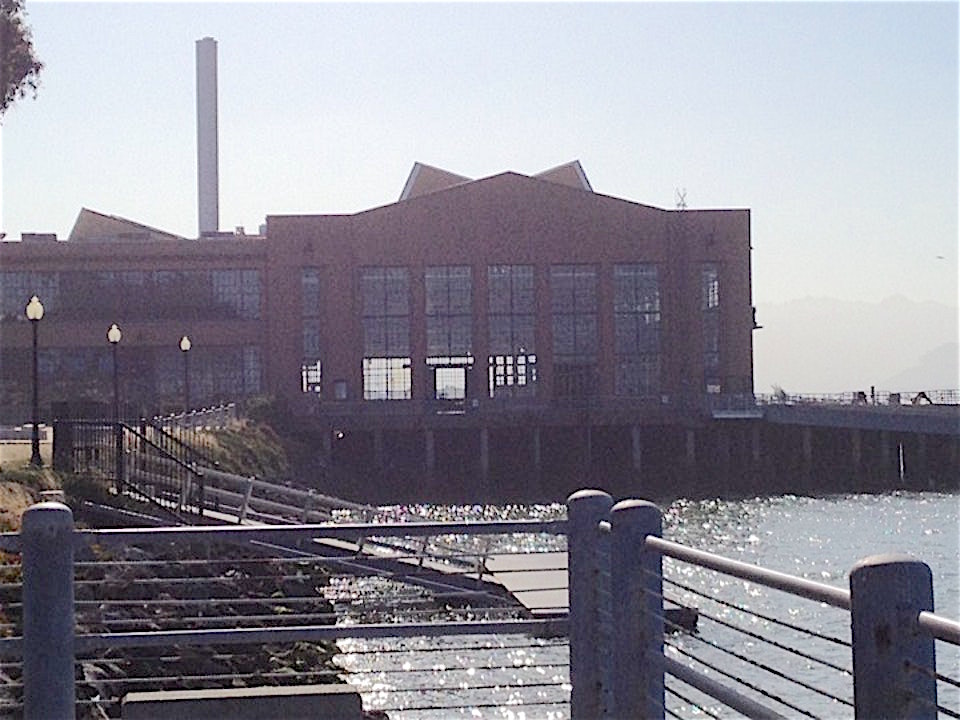
The Pier Rats Speak
Date: June 11, 2002; To: Pier Fishing In California Message Board; From: cougar; Subject: Richmond (dayglo) pier
Where was black marlin when I needed him? Name of pier per songslinger…from 3pm-7pm…2 baby sharks + one 3’ big brother and 2 big daddy’s…thank goodness Paco my new Latino friend was hanging out…after huge initial hit and nice fight, walking fish to rocks while Paco is awaiting w/bare hands…snap…but 4 1/2 ft. 30-40pd. obviously discombobulated…noses up to rock and Paco reaches down and grabs by the tail drags up on rock and slips…he gets up and grabs shark again and brings up to pier…unreal this dude was ballsy to say the least…after seeing sharp thorn on back fin we couldn’t believe he didn’t get pricked…normally I will throw back sharks but Paco insist on keeping it…he goes to his car, grabs knife, sharpens on rocks, and proceeds to clean and slice into steaks…stuffs cooler and heads to Antioch…hour later bam, yank pole and thought I lost it. Other pole gets a hit and I grab it…reel in and its a baby shark, unhook him and throw back…go over to big rig thinking i need to redo bait and holy moly….zzzzzzzz…start getting spooled to the Matson ship across channel…after 10-15 min….finally get monster to the rocks and another fellow helps land him….4-5 ft..30-40 pounds. Got pics in Instamatic and threw him back… After lactic acid in right arm settles down…I decide to pack it up and head home…this one had spots on it but no stripes…not sure what it was…these beasts have a cool way of playing possum.. well here’s to Paco and his carne asada fish tacos….later daze…
Posted by Songslinger
Yeah, Great stuff! Bait?
Posted by cougar
Sardines on 9.0/hk w/ 30pd. Spider line/40pd. leader…on Joisy flounder rig…and 15’ surf rod…catch ya on da flip side …later daze…
Posted by Bayfisherman
So you’re cougar. First time I saw a fellow board member. I got there just after you landed the monster. I was the guy in the yellow CAL hat. Anyway, I stayed to 8:00pm. Used squid on a sliding rig and had two bites one of which I missed the other turned out to be a 25” smoothhound. By the way, Cougar was using sardines for bait, because he had given the fellow who helped him land the last shark some.
Posted by cougar
Bayfisherman…thanks 4 helping land the beast, especially enjoyed the way you just picked the sucker up out of the water by its head w/no gloves…next time I’ll carry more thread…congrats on the smoothhound..
Posted by Red Fish
Good catch. I believe the “Richmond Pier” is better than Emeryville right now. Years ago before the fishing pier was built there, that place was loaded with perch in the pilings of the dilapidated dock that was used to load cargo containers onto the trains.
Back then, my Richmond buddies and I would sit there on the shore and cast towards the broken structure. Mainly perch, but sometimes we would cast out and get a leopard.
Note: there are always some big leopards around an area where perch are around because this is one of their primary natural baits. Perch is a top bait for leopards. I used to use whole shinerperch (deadbait) or strips of a larger perch on a huge hook with the hook exposed. Works wonders. Also, there are stripers there from what I’m told, so if you use a shiner, you have a chance of hooking one of those puppies as well. Fish On!!!!!! Red-
Songslinger later commented: “Cougar and I gave it the sobriquet because anyone who ate a fish there could read by his own light.”
Potpourri — Perhaps more than you want to know about the Sheridan Observation Point Pier
<*}}}}}}}}}>< — Adjacent on the left side of the pier is a small dock for boats. Left of that is the ferry landing and left of that is the old Ford Assembly Plant that opened in 1931—the largest automobile assembly plant on the West Coast.
In World War II the plant was retooled and began producing jeeps and tanks, a task that lasted until the end of the war; car production resumed in 1946. In 1955 manufacturing moved elsewhere and the building saw several different uses until 1989 and the Loma Prieta earthquake. It was basically destroyed and abandoned at that time.
In 2004 the building was purchased and revitalization began that has resulted in several awards. The Craneway Pavilion, a 45,000 square foot section at the southernmost section of the building now offers the largest event space in the Bay Area.
<*}}}}}}}}}>< — The Rosie the Riveter/WWII Home Front National Historical Park surrounds in an inverted L-shape building the old Ford plant. The entrance is on Harbor Way South. If you’re a history buff, as I am, it’s a fascinating and somewhat different look at American history.
<*}}}}}}}}}>< — The other side of the National Historical Park sees another city park, the Lucretia Edwards Shoreline Park. The park “honors the wartime contributions made by Bay Area Shipyards during World War II.” Included is a plaza that highlights Kaiser Shipyard where 747 Liberty and Victory ships were produced for the United States Navy.
<*}}}}}}}}}>< — The waters of the Harbor Channel sit to the right (west) side of the park. Across that channel sits an industrial area (including the Point Potrero Marine Terminal) but what stands out is a large old Navy ship. It’s the SS Red Oak Victory, the last surviving Victory ship built by the Kaiser Richmond Shipyards in World War II. It’s open for tours and run by the Richmond Historical Society.
History. It seems a little hard to believe today but the entire Richmond shoreline was at one time a pristine bay front environment, land that ended in tidal marsh at the edge of the great estuary—San Francisco bay. It was land used but little changed by the Huchiun tribe of the native Ohlone Indians.
With the development of Oakland and San Francisco in the second half of the nineteenth century, more and more people and more and more business moved into the area.
Then, in the early 20thcentury, as Standard Oil and the Santa Fe Railroad moved into the area, an even greater transformation took place. Eventually the area around Richmond’s Inner Harbor area became primarily an industrial area, often with heavy industry and much of the shoreline was lost to public use.
The heavy industrial use peaked in the ‘40s during WWII but continued into roughly the 1970s when more and more plants began to close. The Loma Prieta earthquake of 1989 quickened the pace of closures.
At the same time, more and more people were fighting for public access and eventually this park, as well several others, were opened to provide that access.
The park and pier were originally designed as a site for observation, hence its name, but the pier eventually was given the name “Marina Fishing Area Boardwalk” and it was used by a steady stream of anglers.
The pier was closed for a short period of time in January 2016 when someone started a fire on the pier that resulted in a large hole that necessitated repair.
For a time it looked like the pier would be closed, the result of the decision to build the Richmond Ferry Terminal between the pier and the old assembly plant. I visited it in 2018 and work on the ferry terminal was progressing at a speedy pace while the nearby pier set in disarray. The railings had been taken down and the area was blocked off. The ridiculed and somewhat ignominious pier appeared to be history. But like a phoenix it has arisen once again.
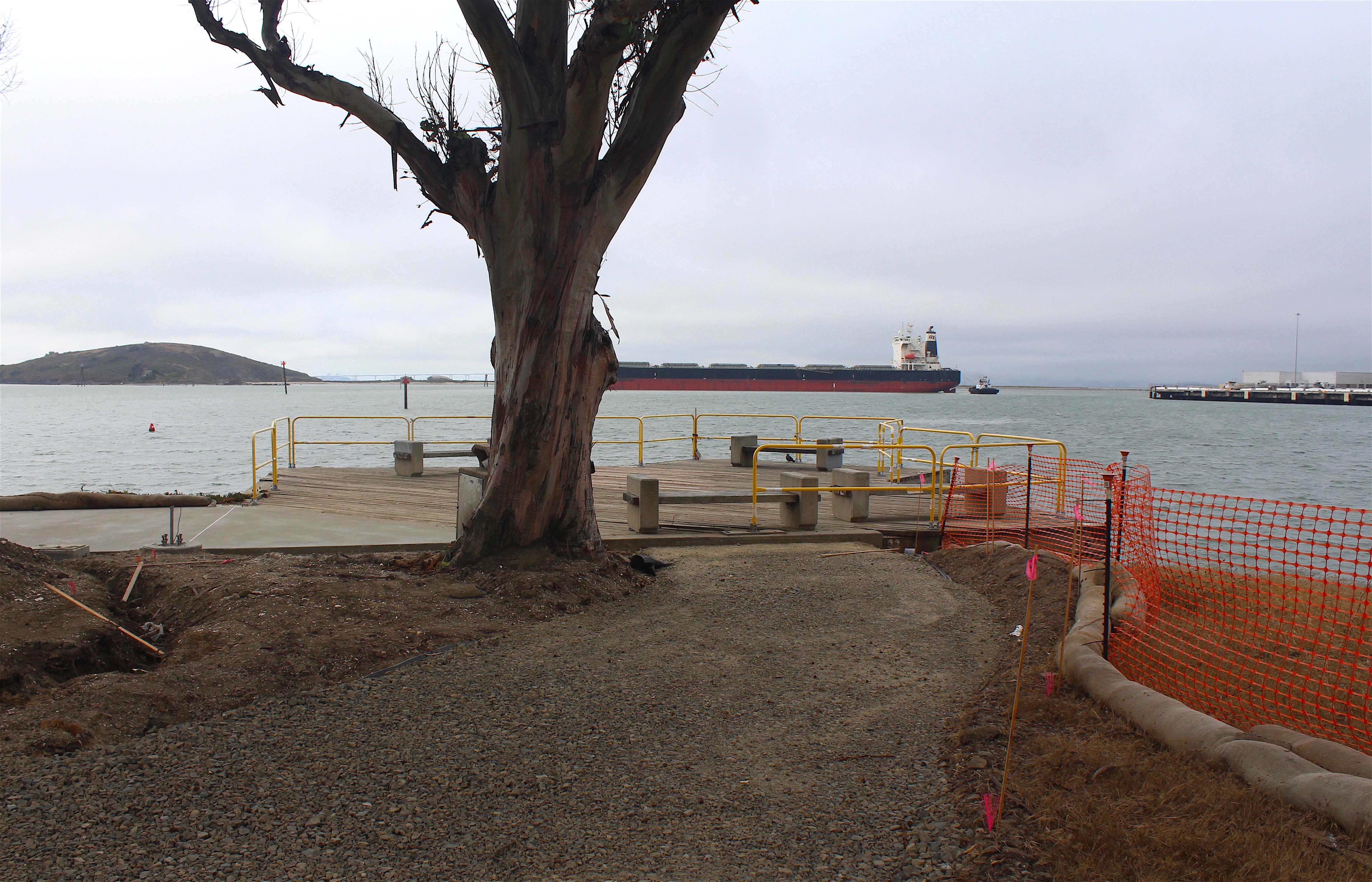
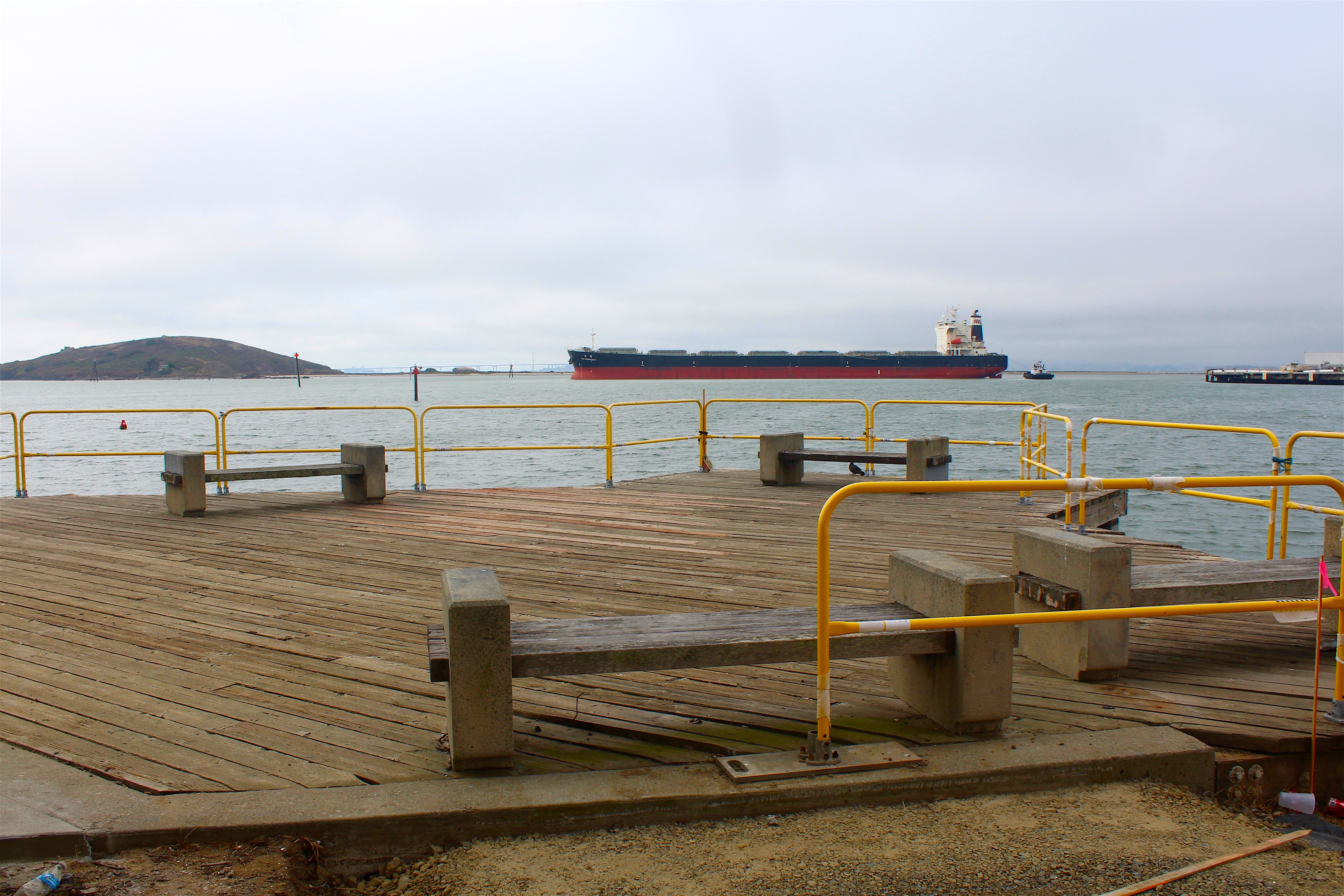
Pictures during the closure
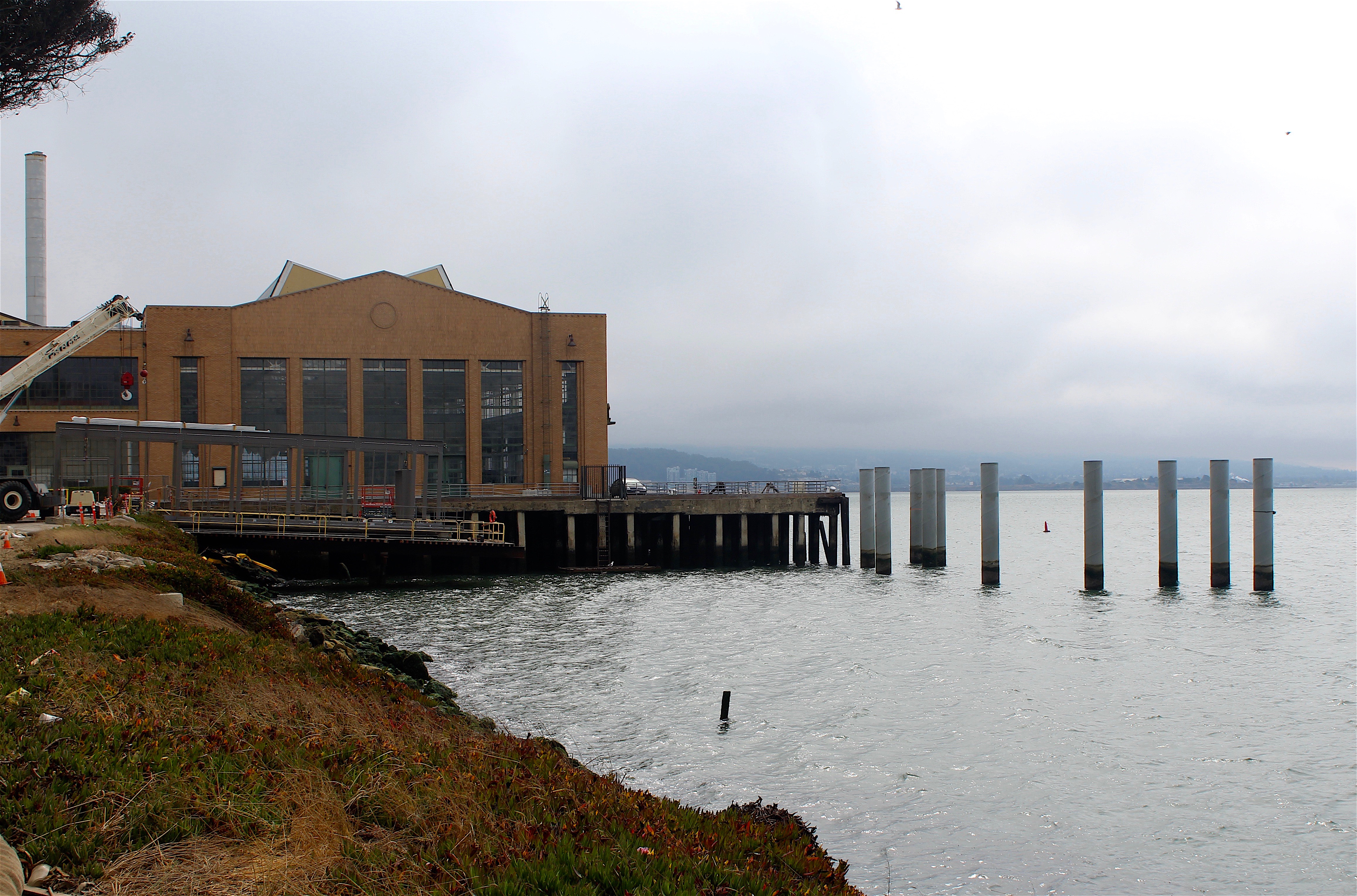
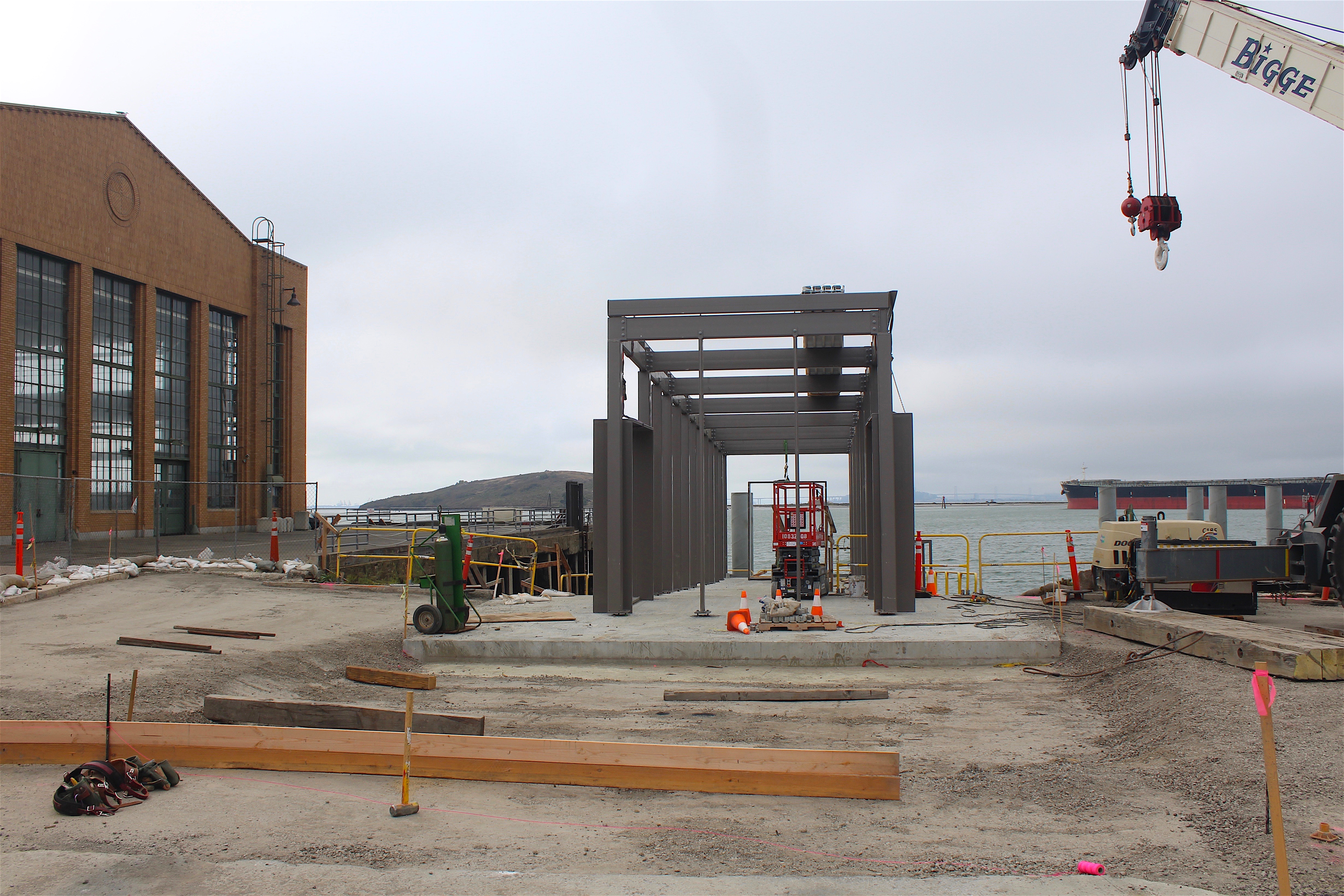
Construction of the new Richmond Ferry Terminal
